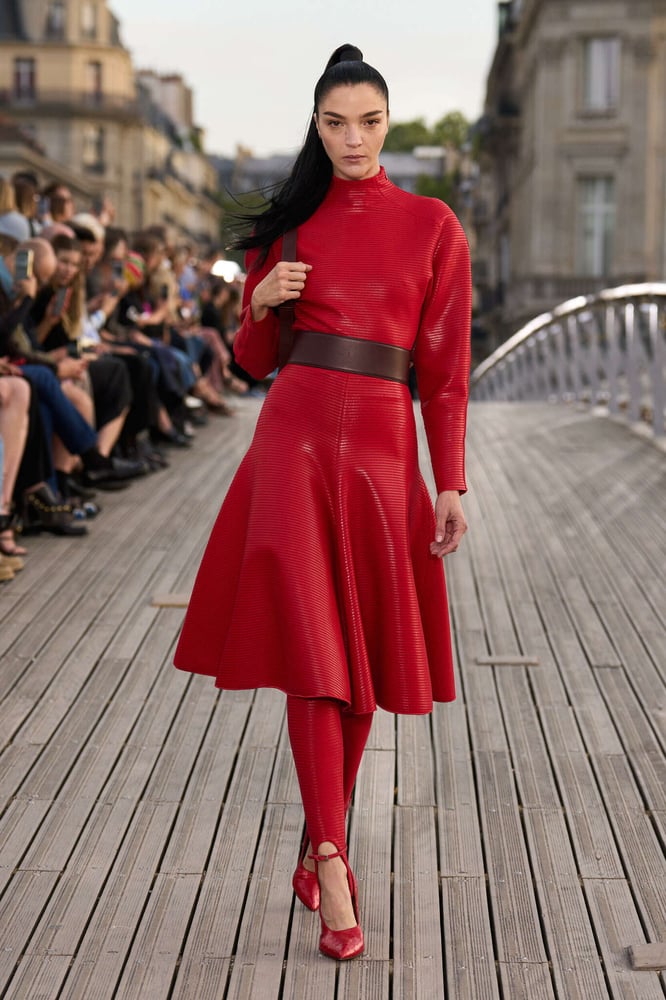Richemont has “resilient” Q1, Alaïa stays strong but YNAP sales fall again
Luxury giant Richemont’s Q1 results on Tuesday showed the fashion-to-fine jewellery brand owner with “resilient” sales in the three months to 30 June. But while Alaïa prospered, Chloé and YNAP were less buoyant.
What does the word “resilient” mean in practice? Sales didn’t exactly leap ahead but the group managed to avoid a general decline in what remained an undeniably tough market globally.
For instance, sales were up 1% at constant exchange rates, although down 1% at actual exchange rates, “against demanding comparatives in the prior-year period”, when they’d been up 19% and 14%, respectively.
And growth was seen across all regions, except for Asia Pacific, driven by Japan and the Americas, both at actual and constant exchange rates. The American advance was particularly encouraging given how difficult that market has been for many luxury firms of late.
The company also said it saw a “further progression” in direct-to-client sales, most notably at its Jewellery Maisons. They enjoyed mid-single digit growth, as did the group’s ‘Other’ business area (which includes its Fashion & Accessories Maisons such as Chloé and Alaïa), “offsetting lower sales at the Specialist Watchmakers impacted by strong exposure to Asia Pacific”.
So let’s look at the numbers in more detail. Total revenue reached €5.268 billion. That divided into €1.17 billion in Europe, which was up 5% at constant rates and 4% at actual rates. Asia Pacific, however, was down 18% and 19% at those rates to €1.809 billion. The Americas jumped 10% and 11% to €1.215 billion. Japan rose 59% and 42% to reach €603 million and the Middle East and Africa was up 8% and 9% at €470 million.
By distribution channel those figures divided into a 2% rise at constant rates but flat sales of €3.631 billion at actual rates for the Retail segment. Online retail was up 6% at both constant and actual rates reaching €315 million. And wholesale and royalty income dropped 5% and 6%, down to €1.322 billion.
By business area, Jewellery was up 4% constant and 2% actual at €3.656 billion, while Specialist Watchmakers fell 13% and 14% to dip below the billion level with revenue of ‘only’ €911 million. The Other division rose 6% on both measures to hit €701 million.
Chinese decline
Looking specifically at the figures from a constant exchange rate point of view, the company talked of a “continuing uncertain macroeconomic and geopolitical environment”.
It said that higher sales in South Korea and Malaysia only partially mitigated a 27% decline in China, Hong Kong and Macau combined. The decline reflected both “the low level of consumer confidence and the strong comparatives ranging from double-digit growth in the mainland to triple digits in Hong Kong and Macau over the prior-year period”. It seems that the trend of Chinese shoppers spending their money on luxury items at home has reversed with a definite return to international shopping tourism on their part.
In Europe, the higher sales were “driven by resilient local demand and stronger tourist purchases”, while in the Americas, the 10% sales uplift “reflected sustained domestic demand across all distribution channels”.
That super-strong sales growth in Japan came on top of strong comparatives in the prior-year period and was fuelled by domestic demand as well as “thriving tourist spending from Chinese, South Korean, South-East Asian and American clients, favoured by a weakened yen”. Sales in the Middle East & Africa benefitted from growing domestic and tourist spending in the UAE and Saudi Arabia.
As mentioned, sales growth in the Retail and Online retail channels offset a sales decline in the Wholesale channel. Retail sales, which accounted for 69% of group sales, were driven largely by mid-single-digit growth at the Jewellery Maisons. The Online retail sales rise was helped by sustained by growth at Watchfinder as well as the Jewellery and Fashion & Accessories Maisons. The 5% sales decline in the Wholesale channel primarily reflected weaker performance in Asia Pacific.
Fashion ups and downs
The group’s Other business saw that 6% sales rise as mentioned, “underpinned by a double-digit progression at Watchfinder and a 4% growth at the Group’s Fashion & Accessories Maisons, which included Gianvito Rossi, consolidated since 1 February 2024”.
The “ongoing momentum of Alaïa and Peter Millar broadly compensated for softer sales at most of the other Maisons, including at Chloé where the debut collection under the new creative director only reached stores at the end of the quarter under review”.
The group’s three Jewellery Maisons – Buccellati, Cartier and Van Cleef & Arpels – delivered a 4% sales growth “against demanding comparatives” with the year before having seen a 24% jump. Their growth was supported by both jewellery and watches.
But the decline in sales at the Specialist Watchmakers was bad news. Japan’s “noteworthy performance only partially offset lower sales in Europe and Asia Pacific, particularly in China, Hong Kong and Macau combined. Of note was the resilience of Vacheron Constantin and A. Lange & Söhne”.
And what of the ailing Yoox Net-A-Porter operation that’s still part of Richemont but that’s also presented as ‘discontinued operations’? It posted a 15% sales reduction, both at constant and actual exchange rates. The company gave no extra details around this, but that figure certainly underlined the importance of its ongoing strategy to divest that particular business.
Copyright © 2024 FashionNetwork.com All rights reserved.



